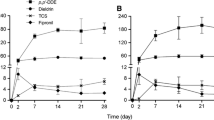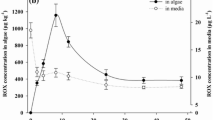Abstract
Food chain transfer of polychlorinated biphenyls (PCBs) was studied by feeding contaminated fungus,Fusarium oxysporum, to the amphipod,Gammarus tigrinus, both isolated from the Hudson River. Apparent distribution coefficients (μg PCB/g dry wt. fungus // μg PCB/g medium) of 1.14–1.33 × 103 were determined when14C-Aroclor 1254 at 0.007 μg/g was added to 4-day old fungal growth for 24 hr. InG. tigrinus fed contaminated fungus, cross-gut PCB assimilation was indicated. Rapid PCB uptake occurred with a constant level achieved between 9 and 24 hr. Over a period of 144 hr, 57% of accumulated PCBs were eliminated. The results suggest that dietary uptake may contribute substantially to PCB levels inGammarus.
Similar content being viewed by others
References
Barlocher F, Kendrick B (1973a) Fungi in the diet ofGammarus pseudolimnaeus (Amphipoda). Oikos 24:295–300
— (1973b) Fungi and food preferences ofGammarus pseu-dolimnaeus. Arch Hydrobiol 72:501–516
Bopp RF, Simpson HJ, Olsen CR, Kostyk N (1981) Polychlo-rinated biphenyls in sediments of the tidal Hudson River. Environ Sci Technol 15:210–216
Bousfield EL (1969) New records ofGammarus (Crustacea: amphipoda) from the middle Atlantic region. Chesapeake Sci 10:1–17.
Duddridge JE, Wainwright M (1980) Heavy metal accumulation by aquatic fungi and reduction in viability ofGammarus pulex fed Cd+2 contaminated mycelium. Water Res 14:1605–1611
Gardinier MN, Hoff TB (1982) Diet of striped bass in the Hudson River estuary. New York Fish Game J 29:152–165
Grabe SA (1980) Food of age 1 and 2 Atlantic tomcod,Microgadus tomcod, from Haverstraw Bay, Hudson River, New York. Fish Bull 77:1003–1006
Greze II (1968) Feeding habits and food requirements of some amphipods in the Black Sea. Mar Biol 1:316–321
Kaushik NK, Hynes HBN (1971) The fate of dead leaves that fall into streams. Arch Hydrobiol 68:465–515
Kostalos M, Seymour RL (1976) Role of microbial enriched detritus in the nutrition ofGammarus minus (Amphipoda). Oikos 27:512–516
Lynch TR, Johnson HE (1982) Availability of a hexachlorobiphenyl isomer to benthic amphipods from experimentally contaminated natural sediments. In: Pearson JG, Foster RB, Bishop WE (eds) Aquatic toxicology and hazard assessment: Fifth conference. American Society for Testing and Materials, STP 766, Philadelphia, PA, pp 273–287
McFadden JT (1978) Influence of the proposed Cornwall pumped storage project and steam electric generating plants on the Hudson River estuary with emphasis on striped bass and other fish populations, revised. Prepared for Consolidated Edison Co., New York
Marinucci AC, Bartha R (1982) Accumulation of the polychlo-rinated biphenyl Aroclor 1242 from contaminated detritus and water by the saltmarsh detritivore,Uca pugnax. Bull Environ Contam Toxicol 29:326–333
Nebeker AV, Puglisi FA (1974) Effect of polychlorinated biphenyls (PCBs) on survival and reproduction ofDaphnia, Gammarus, andTanytarsus. Trans Am Fish Soc 103:722–728
New York State Department Environmental Conservation (1981) PCBs in the Hudson River. A reclamation program. Albany, New York, 2 pp
O'Connor JM (1982) Seasonal aspects of PCB contamination in theGammarus species complex in the Hudson River. Report to the New York State Dept Environ Conserv, Albany, New York 160 pp
Paris DF, Lewis DL, Barnett JT (1977) Bioconcentration of toxaphene by microorganisms. Bull Environ Contam Toxicol 17:564–572
Paris DF, Steen WC, Baughman GL (1978) Role of physico-chemical properties of Aroclors 1016 and 1242 in determining their fate and transport in aquatic environments. Chemosphere 4:319–325
Peters LS, O'Connor JM (1982) Factors affecting short-term PCB and DDT accumulation by zooplankton and fish from the Hudson estuary. In: Mayer GF (ed) Ecological stress and the New York Bight: Science and management. Estuarine Research Federation, Charleston, South Carolina, pp 451–467
Pizza JC, O'Connor JM (1983) PCB dynamics in Hudson River striped bass. II. Accumulation from dietary sources. Aquatic Toxicol 3:313–327
Poje GV (1977) Growth, reproduction and respiration of the estuarine amphipodGammarus tigrinus. M. S. Thesis, New York University, New York, 58 pp
Sanders HO, Chandler JH (1972) Biological magnification of a polychlorinated biphenyl (Aroclor 1254) from water by aquatic invertebrates. Bull Environ Contam Toxicol 7:257–263
Sansur RM (1982) Metabolism of the polychlorinated biphenyls (PCBs), Aroclor 1254, by the fungus,Fusarium oxysporum. Dissertation, New York University, New York, 126 pp
Thomann RV (1981) Equilibrium model of fate of microcontaminants in diverse aquatic food chains. Can J Fish Aquat Sci 38:280–296
Willoughby LG, Earnshaw R (1982) Gut passage times inGammarus pulex (Crustacea, Amphipoda) and aspects of summer feeding in a stony stream. Hydrobiologia 97:105–117
Author information
Authors and Affiliations
Rights and permissions
About this article
Cite this article
Pinkney, A.E., Poje, G.V., Sansur, R.M. et al. Uptake and Retention of14C-Aroclor® 1254 in the Amphipod,Gammarus tigrinus, Fed Contaminated Fungus,Fusarium oxysporum . Arch. Environ. Contam. Toxicol. 14, 59–64 (1985). https://doi.org/10.1007/BF01055762
Received:
Revised:
Issue Date:
DOI: https://doi.org/10.1007/BF01055762




